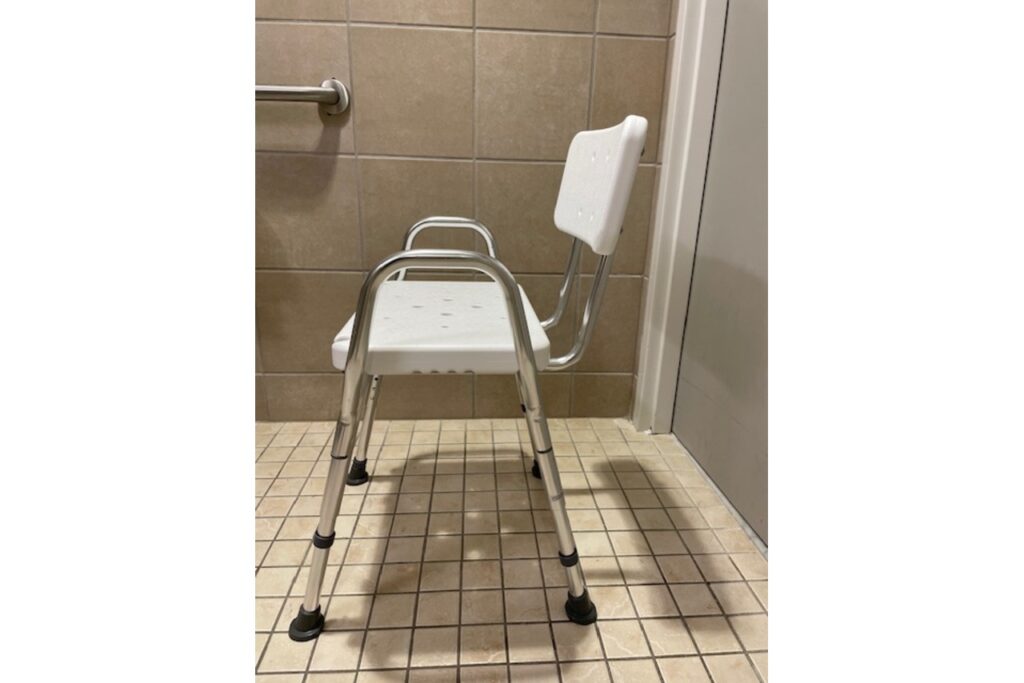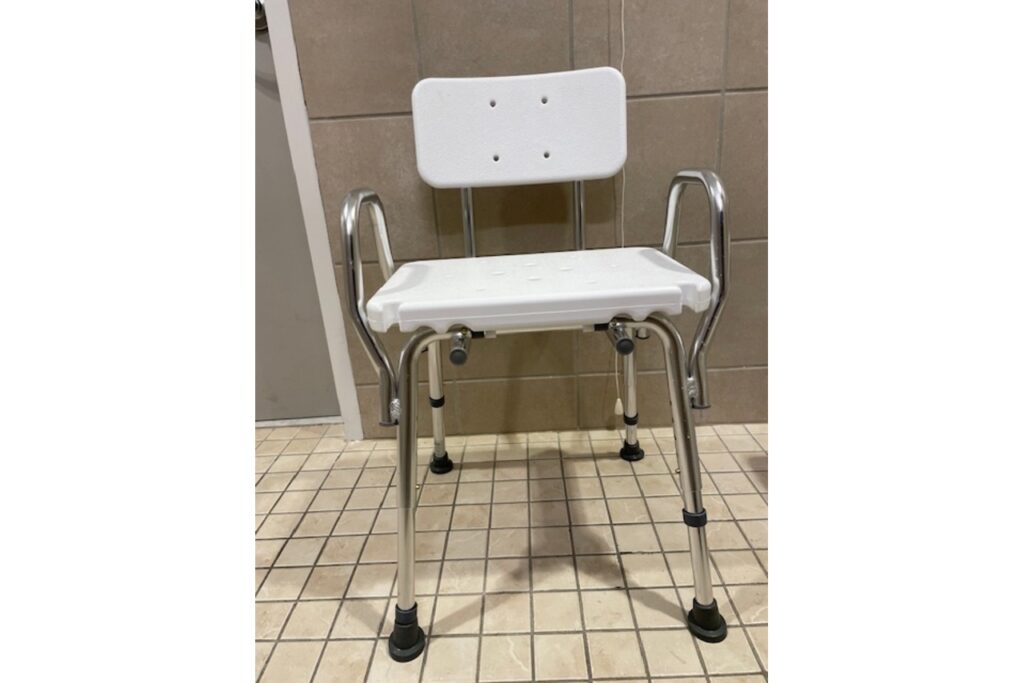Navigating the challenges of aging can often bring about concerns related to safety and independence, especially in everyday activities such as bathing. For seniors, maintaining personal hygiene shouldn’t be a daunting task. The shower chair can serve as a crucial tool in promoting safety and confidence for older adults. This article explains the significance of shower chairs, highlighting their role in enhancing the quality of life for older adults.
What is a Shower Chair?

A shower chair is a specially designed seat that fits inside a shower or bathtub, providing a safe and stable place for individuals to sit while bathing. Tailored for those who face challenges with balance or mobility, shower chairs come in various forms to cater to different needs.
Standard shower chairs generally come with non-slip legs, a sturdy seat, and may include backrests for additional support. Some models offer armrests, which provide further stability and comfort. For the older adult who may require extra assistance, transfer benches are a popular variant. They extend beyond the bathtub, allowing easy and safe transitions into the shower area.
The adjustable shower chair, offers customizable features such as height regulation and removable components, ensuring the seat fits perfectly to individual needs. Each type serves the fundamental purpose of enhancing safety and ease during showering, making it an indispensable part of bathroom setups for seniors.
Importance of Shower Chairs in Occupational Therapy
In occupational therapy, the focus is on helping individuals regain or maintain independence in their daily activities. For older adults, shower chairs become an essential part of this therapeutic approach. They address one of the key activities of daily living, bathing, by providing a secure environment that minimizes the risk of slips and falls.
Occupational therapists often recommend shower chairs as they help seniors perform bathing independently, a vital aspect of self-care. This independence boosts confidence, contributing significantly to the mental well-being of older adults individuals. By using a shower chair, seniors can enjoy a newfound sense of autonomy, which is central to occupational therapy goals.
Shower chairs reduce the physical strain involved in assisting older adults with bathing, making the process safer and more comfortable for everyone involved. This dual benefit underscores the importance of shower chairs in the broader context of occupational therapy.
Benefits of Using a Shower Chair
Using a shower chair brings a host of benefits, both physically and mentally, for older adults. The most obvious advantage is the prevention of accidents. Bathrooms can be slippery spaces, and the added security of a shower chair significantly reduces the risk of falls, providing peace of mind for both seniors and their families.
Beyond physical safety, shower chairs offer mental health benefits by promoting confidence and reducing anxiety around bathing. Older adults can regain a level of independence, which positively impacts their self-esteem and overall well-being. Knowing they can bathe without assistance empowers them to take on other daily activities with renewed enthusiasm.
Additionally, shower chairs contribute to energy conservation. Standing for extended periods can be exhausting, especially for those with limited stamina or health issues. A shower chair allows for a comfortable, seated position, making the bathing process less tiring. This energy conservation enables seniors to engage in other activities throughout their day without fatigue.
Choosing the Right Shower Chair
Selecting the appropriate shower chair involves considering several factors to ensure safety, comfort, and efficacy. First, assess the size of the shower or bathtub to determine the chair’s dimensions. It’s crucial to choose a chair that fits comfortably within the space, providing ample room for movement while ensuring stability.
Weight capacity is another important consideration. Check the chair’s weight limit to ensure it can safely support the user. Most shower chairs are designed to accommodate various body weights, but it’s essential to verify this aspect before purchasing.
Special features, such as adjustable height, padded seats, and armrests, can enhance user comfort and ease of use. Look for non-slip materials or rubber-tipped legs that prevent the chair from sliding in wet conditions. By paying attention to these factors, you can select a shower chair that meets individual needs and enhances the overall bathing experience.
How to Use a Shower Chair Safely

Ensuring safe use of a shower chair involves understanding proper setup and usage guidelines. Begin by placing the chair on a flat surface within the shower or bathtub, ensuring the legs are stable and evenly positioned. If the chair has adjustable legs, customize the height to suit the user’s preference, allowing for easy access and exit.
Before sitting, test the chair’s stability by applying some pressure to ensure it remains steady. Encourage the user to hold onto the armrests, if available, when sitting down or standing up, as this provides additional support and balance.
During use, keep essential bathing items within arm’s reach to minimize movements that could lead to slips. It’s also beneficial to install grab bars in the shower area, offering extra security for the user. By following these tips, the elderly can safely enjoy the benefits of their shower chair, making bathing a safe and pleasant experience.
Conclusion
In summary, shower chairs play a vital role in supporting older adults, especially within the framework of occupational therapy. They offer a practical solution to the challenges of bathing by enhancing safety, promoting independence, and providing peace of mind. By understanding the different types of shower chairs, considering key features before purchasing, and following safe usage practices, seniors can enjoy a better quality of life.
The information provided on this website is for general informational purposes only. It is not intended as, nor should it be considered, professional or medical advice. Always consult a professional regarding your specific medical issue.
Frequently Asked Questions
How do I know if a shower chair is right for me or my loved one?
A shower chair is recommended for individuals who have difficulty standing for extended periods, are at risk of falling, or require support during bathing tasks. Consulting with a healthcare professional or occupational therapist can help determine if a shower chair is suitable for your specific needs.
What are the maintenance tips for a shower chair?
Regular maintenance of a shower chair is vital to ensure its longevity and safety. Clean the chair regularly with mild soap and water to prevent mold and mildew buildup. Inspect the chair for any signs of wear or damage, such as cracks in the seat or instability in the legs and address any issues immediately.
Can a shower chair fit in any bathtub or shower?
Shower chairs come in various sizes and designs tailored to different spaces. It’s crucial to measure the dimensions of your bathtub or shower to ensure the chosen chair fits comfortably, providing the required accessibility and movement for optimal use.
How can I enhance the stability of a shower chair?
To enhance stability, ensure the chair is placed on a flat surface and make sure all four legs are evenly adjusted. Consider adding non-slip materials or ensuring that the chair’s legs have rubber tips to prevent sliding. Use additional support tools like grab bars for increased safety.
Are there alternatives to shower chairs for bathing assistance?
Yes, other aids such as shower stools and transfer benches can also facilitate safe and comfortable bathing. These options vary in design and functionality, so it’s essential to evaluate personal needs and space constraints to choose the most suitable option.
References:
- American Occupational Therapy Association (AOTA). “Assistive Devices: Promoting Independence & Safety for the Elderly.”
- National Institute on Aging (NIA). “Recommendations on Enhancing Quality of Life for Older Adults.”
- Centers for Disease Control and Prevention (CDC). “Home Safety Guidelines for Seniors: Focus on Fall Prevention.”
- Journal of Gerontological Nursing. “Impact of Shower Chairs on Senior Independence and Safety in Occupational Therapy.” Journal of Gerontological Nursing, Vol 47, No 9.
Recently Featured OT Insider Posts
How to Create a Sensory-Friendly Halloween for Children
Dx Medical Abbreviation: Everything You Need to Know
The Front Wheeled Walker: How to Manage Mobility in Rehab
PO Medical Abbreviation: Everything You Need to Know
Hemi Walker: How It’s Used in Rehabilitative Therapy
PCN Medical Abbreviation: Everything You Need to Know
ETOH Medical Abbreviation: Everything Your Need to Know
HS Medical Abbreviation: Understanding Hidradenitis Suppurativa
